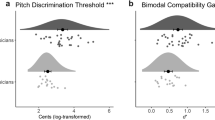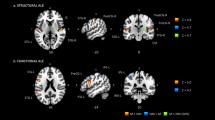Abstract
Music perceptual abilities are subjective and exhibit high inter-individual variability. Twenty-nine participants with varying degrees of musical training were tested for musical perception ability with the Profile of Music Perception Skills (PROMS) and brain structural measures obtained via diffusion tensor imaging. Controlling for the period of training, TBSS results showed that individuals with better musical perception abilities showed increased deviations from linear anisotropy in the corpus callosum. Specifically, mode of anisotropy in the genu and body of the corpus callosum was negatively correlated with music perception score suggesting the presence of crossing fibers. A multi-compartment model of crossing fibers revealed a significant positive relation for partial volumes of secondary fiber populations with timing aspects of music perception. Our results suggest that inter-hemispheric connectivity differences in the anterior parts of the corpus callosum may reflect innate differences in the processing of the rhythmic aspects of music.




Similar content being viewed by others
References
Aboitiz F, Scheibel AB, Fisher RS, Zaidel E (1992) Fiber composition of the human corpus callosum. Brain Res 598:143–153
Aboitiz F, López J, Montiel J (2003) Long distance communication in the human brain: timing constraints for inter-hemispheric synchrony and the origin of brain lateralization. Biol Res 36:89–99
Assaf Y, Blumenfeld-Katzir T, Yovel Y, Basser PJ (2008) AxCaliber: a method for measuring axon diameter distribution from diffusion MRI. Magn Reson Med 59:1347–1354
Avants BB, Epstein CL, Grossman M, Gee JC (2008) Symmetric diffeomorphic image registration with cross-correlation: evaluating automated labeling of elderly and neurodegenerative brain. Med Image Anal 12:26–41
Basser PJ, Mattiello J, LeBihan D (1994) Estimation of the effective self-diffusion tensor from the NMR spin echo. J Magn Reson 103:247–254
Behrens TE, Berg HJ, Jbabdi S, Rushworth MFS, Woolrich MW (2007) Probabilistic diffusion tractography with multiple fiber orientations: what can we gain ? Neuroimage. 34:144–155
Bengtsson SL, Nagy Z, Skare S, Forsman L, Forssberg H, Ullén F (2005) Extensive piano practicing has regionally specific effects on white matter development. Nat Neurosci 8:1148
Bermudez P, Lerch JP, Evans AC, Zatorre RJ (2008) Neuroanatomical correlates of musicianship as revealed by cortical thickness and voxel-based morphometry. Cereb Cortex 19:1583–1596
Charness N, Ericsson KA (1994) Expert performance: its structure and acquisition. American Psychology. 49:725–747
Chen JL, Penhune VB, Zatorre RJ (2008) Listening to musical rhythms recruits motor regions of the brain. Cereb Cortex 18:2844–2854
Cheung VK, Meyer L, Friederici AD, Koelsch S (2018) The right inferior frontal gyrus processes nested non-local dependencies in music. Sci Rep 8:3822
de Manzano Ö, Ullén F (2018) Genetic and environmental influences on the phenotypic associations between intelligence, personality, and creative achievement in the arts and sciences. Intelligence 69:123–133
Desikan RS, Ségonne F, Fischl B, Quinn BT, Dickerson BC, Blacker D, Albert MS (2006) An automated labeling system for subdividing the human cerebral cortex on MRI scans into gyral based regions of interest. Neuroimage 31:968–980
Douaud G, Jbabdi S, Behrens TE, Menke RA, Gass A, Monsch AU, Rao A, Whitcher B, Kindlmann G, Matthews PM, Smith S (2011) DTI measures in crossing-fiber areas: increased diffusion anisotropy reveals early white matter alteration in MCI and mild Alzheimer’s disease. Neuroimage 55:880–890
Elmer S, Hänggi J, Jäncke L (2016) Interhemispheric transcallosal connectivity between the left and right planum temporale predicts musicianship, performance in temporal speech processing, and functional specialization. Brain Struct Funct 221:331–344
Engel A, Hijmans BS, Cerliani L, Bangert M, Nanetti L, Keller PE, Keysers C (2014) Inter-individual differences in audio-motor learning of piano melodies and white matter fiber tract architecture. Hum Brain Mapp 35:2483–2497
Ennis DB, Kindlmann G (2006) Orthogonal tensor invariants and the analysis of diffusion tensor magnetic resonance images. Magn Reson Med 146:136–146
Ericsson KA (2007) Deliberate practice and the modifiability of body and mind: toward a science of the structure and acquisition of expert and elite performance. Int J Sport Psychol 38:4
Ericsson KA, Krampe RT, Romer CT (1993) The role of deliberate practice in the acquisition of expert performance. Psychol Rev 100:363–406
Ericsson KA, Roring RW, Nandagopal K (2007) Giftedness and evidence for reproducibly superior performance: an account based on the expert performance framework. High Ability Stud 18:3–56
Fischl B (2012) FreeSurfer. Neuroimage 62:774–781
Foster NEV, Zatorre RJ (2010) Cortical structure predicts success in performing musical transformation judgments. Neuroimage 53:26–36
Galton F (1869) Hereditary genius: an inquiry into its laws and consequences. 27: (Macmillan, 1869)
Gardner H (1995) “Multiple Intelligences” as a Catalyst. Engl J 84:16–18
Gaser C, Schlaug G (2003) Brain structures differ between musicians and non-musicians. J Neurosci 23:9240–9245
Giacosa C, Karpati FJ, Foster NE, Penhune VB, Hyde KL (2016) Dance and music training have different effects on white matter diffusivity in sensorimotor pathways. Neuroimage 135:273–286
Habibi A, Damasio A, Ilari B, Veiga R, Joshi AA, Leahy RM, Haldar JP, Varadarajan D, Bhushan C, Damasio H (2017) Childhood music training induces change in micro and macroscopic brain structure: results from a longitudinal study. Cereb Cortex 28:4336–4347
Halwani GF, Loui P, Rueber T, Schlaug G (2011) Effects of practice and experience on the arcuate fasciculus: comparing singers, instrumentalists, and non-musicians. Front Psychol 2:156
Hambrick DZ, Tucker-Drob EM (2015) The genetics of music accomplishment: evidence for gene–environment correlation and interaction. Psychon Bull Rev 22:112–120
Jbabdi S, Behrens TE, Smith SM (2010) Crossing fibers in tract-based spatial statistics. Neuroimage 49:249–256
Johansen-Berg H, Della-Maggiore V, Behrens TE, Smith SM, Paus T (2007) Integrity of white matter in the corpus callosum correlates with bimanual co-ordination skills. Neuroimage 36:16–21
Karpati FJ, Giacosa C, Foster NE, Penhune VB, Hyde KL (2015) Dance and the brain: a review. Ann N Y Acad Sci 1337:140–146
Law LN, Zentner M (2012) Assessing musical abilities objectively: construction and validation of the profile of music perception skills. PLoS One 7:e52508
Limb CJ (2006) Structural and functional neural correlates of music perception. Anat Record 288:435–446
Macnamara BN, Hambrick DZ, Oswald FL (2014) Deliberate practice and performance in music, games, sports, education, and professions: a meta-analysis. Psychol Sci 25:1608–1618
Micheyl C, Kaernbach C, Demany L (2008) An evaluation of psychophysical models of auditory change perception. Psychol Rev 115:1069
Moore E, Schaefer RS, Bastin ME, Roberts N, Overy K (2014) Can musical training influence brain connectivity? Evidence from diffusion tensor MRI. Brain Sci 4:405–427
Mori S, Zhang J (2006) Principles of diffusion tensor imaging and its applications to basic neuroscience research. Neuron 51:527–539
Mosing MA, Madison G, Pedersen NL, Kuja-Halkola R, Ullén F (2014) Practice does not make perfect: no causal effect of music practice on music ability. Psychol Sci 25:1795–1803
Ohnishi T, Matsuda H, Asada T, Aruga M, Hirakata M, Nishikawa M, Katoh A, Imabayashi E (2001) Functional anatomy of musical perception in musicians. Cereb Cortex 11:754–760
Patston LL, Kirk IJ, Rolfe MHS, Corballis MC, Tippett LJ (2007) The unusual symmetry of musicians: Musicians have equilateral interhemispheric transfer for visual information. Neuropsychologia 45:2059–2065
Raffelt D, Tournier JD, Rose S, Ridgway GR, Henderson R, Crozier S, Salvado O, Connelly A (2012) Apparent fiber density: a novel measure for the analysis of diffusion-weighted magnetic resonance images. Neuroimage 59:3976–3994
Ravignani A, Delgado T, Kirby S (2017) Musical evolution in the lab exhibits rhythmic universals. Nat Hum Behav 1:0007
Savage PE, Brown S, Sakai E, Currie TE (2015) Statistical universals reveal the structures and functions of human music. Proc Natl Acad Sci 112:8987–8992
Schlaug G, Jancke L, Huang Y, Staiger JF, Steinmetz H (1995) Increased corpus callosum size in musicians. Neuropsychologia 33:1047–1055
Schlaug G, Forgeard M, Zhu L, Norton A, Norton A, Winner E (2009) Training-induced neuroplasticity in young children. Ann N Y Acad Sci 1169:205–208
Schmithorst VJ (2005) Separate cortical networks involved in music perception: preliminary functional MRI evidence for modularity of music processing. Neuroimage. 25:444–451
Schneider P, Sluming V, Roberts N, Bleeck S, Rupp A (2005) Structural, functional, and perceptual differences in Heschl’s gyrus and musical instrument preference. Ann N Y Acad Sci 1060:387–394
Seesjärvi E, Särkämö T, Vuoksimaa E, Tervaniemi M, Peretz I, Kaprio J (2016) The nature and nurture of melody: a twin study of musical pitch and rhythm perception. Behav Genet 46:506–515
Smith SM, Jenkinson M, Johansen-Berg H, Rueckert D, Nichols TE, Mackay CE, Watkins KE, Ciccarelli O, Cader MZ, Matthews PM, Behrens TE (2006) Tract-based spatial statistics: voxelwise analysis of multi-subject diffusion data. Neuroimage 31:1487–1505
Steele CJ, Bailey JA, Zatorre RJ, Penhune VB (2013) Early musical training and white-matter plasticity in the corpus callosum: evidence for a sensitive period. J Neurosci 33:1282–1290
Sternberg RJ (1996) Costs of expertise. In: Ericsson KA (ed) The road to excellence: the acquisition of expert performance in the arts and sciences, sports, and games. Lawrence Erlbaum, Mahwah, pp 347–354
Stikov N, Perry LM, Mezer A, Pauly JM, Wandell BA, Dougherty RF (2011) Modeling and measuring the myelin g-ratio. Proc Intl Soc Magn Reson Med 19:225
Thapaliya K, Vegh V, Bollmann S, Barth M (2017) Assessment of microstructural signal compartments across the corpus callosum using multi-echo gradient recalled echo at 7 T. Neuroimage 182:407–416
Turker S, Reiterer SM, Seither-preisler A, Schneider P (2017) ‘When music speaks’: auditory cortex morphology as a neuroanatomical marker of language aptitude and musicality. Front Psychol 8:1–17
Vaquero L, Ramos-Escobar N, François C, Penhune V, Rodríguez-Fornells A (2018) White-matter structural connectivity predicts short-term melody and rhythm learning in non-musicians. NeuroImage 181:252–262
Yoncheva YN, Somandepalli K, Reiss PT, Kelly C, Di Martino A, Lazar M, Zhou J, Milham MP, Castellanos FX (2016) Mode of anisotropy reveals global diffusion alterations in attention-deficit/hyperactivity disorder. J Am Acad Child Adolesc Psychiatry 55:137–145
Zatorre RJ (2013) Predispositions and plasticity in music and speech learning: neural correlates and implications. Science 342:585–589
Zentner M, Strauss H (2017) Assessing musical ability quickly and objectively: development and validation of the Short-PROMS and the Mini-PROMS. Ann N Y Acad Sci 1400:33–45
Author information
Authors and Affiliations
Corresponding author
Ethics declarations
Conflict of interest
The authors declare that they have no conflict of interest.
Ethical statement
All procedures performed in studies involving human participants were in accordance with the ethical standards of the institutional research committee of the National Brain Research Centre, Manesar, and were in compliance with the 1964 Helsinki declaration and its later amendments or comparable ethical standards.
Informed consent
Written and informed consent was obtained from all individual participants included in the study.
Additional information
Publisher's Note
Springer Nature remains neutral with regard to jurisdictional claims in published maps and institutional affiliations.
Rights and permissions
About this article
Cite this article
Rajan, A., Valla, J.M., Alappatt, J.A. et al. Wired for musical rhythm? A diffusion MRI-based study of individual differences in music perception. Brain Struct Funct 224, 1711–1722 (2019). https://doi.org/10.1007/s00429-019-01868-y
Received:
Accepted:
Published:
Issue Date:
DOI: https://doi.org/10.1007/s00429-019-01868-y




